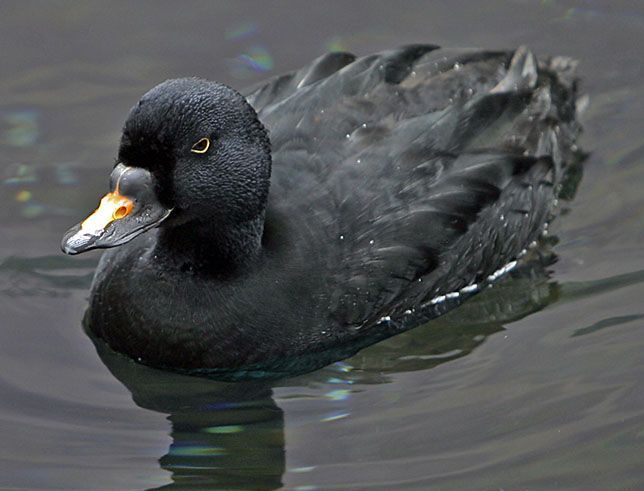
Common scoter(Melanitta nigra)
Phylum —chordata
Class — aves
Order — anseriformes
Family — anatidae
Genus –melanitta
Appearance
Common scoters are the smallest, most compact of the scoters with relatively small bills and rounded heads. Adult males are solid black except for a butter-colored swelling at the base of the bill. Male common scoters have a total length of 49 cm with a mass of 1100 g, while females are 45 cm in length and weigh 980 g. Females are dark brown with a pale cheek and a dark crown. The underwings of common scoters are completely dark and unpatterned. However, adult males have a completely black upperwing, while adult females and immature black scoters have a dark brown upperwing. Immature birds resemble the female but are more mottled with white on the breast and belly. New hatchlings are dark brown or sooty black on the back that gradually fade to light grey underneath.
Habitat
Common scoters breed from Iceland, the British Isles, and Norway east to Russia and Siberia. Their range extends to the lower Khantanga drainage and down to the Kamchatka Peninsula. Common scoters winter primarily in the Baltic and North Sea area from northern Norway south along the coast to Portugal and out to sea as far as the Azores. They may winter south to Japan, Korea, and occasionally eastern China.
Behavior
This species is not known to be territorial beyond a male defending the moving space around a female during breeding season. Physical interaction occurs mostly in courting parties but they tend to sleep in tight flocks on the water. During the day, they spend most of their time feeding and will form small groups to do so. If other species intrude, then males or females will rush as a threat display.
Common scoters are highly gregarious during non-mating seasons, having large flocks from several hundred to a thousand though over 100,000 individuals have been seen during the winter.
Diet
Common scoters are a type of diving duck that feeds on prey species that live within the upper substratum of the water. Their diet is mostly composed of bivalve mollusks with crabs, small fish, and gastropods also included.
Reproduction
Common scoters appear to be monogamous. However, forced copulation events may occur.
Common scoter pair formation likely occurs upon arrival on wintering grounds during late fall and winter. However, courtship activity also occurs in the spring. There is usually a single female with several males in courting groups. Males will display with an upward stretch of the head, tail snap, forward rush, water flicked by the bill, a breast-preen, forward stretch, erect, and then a head shake. Females will show their preference by head stretch posture and calling. In addition, they will show aggression to all other males.
Melanitta nigra arrives at breeding grounds between late-April and May but breed from late-May to June in solitary pairs. After June, males migrate to inshore or to offshore coastal waters for their flightless moult. Nests hatching occurs at this time. However, this time varies depending on weather conditions. Females and young remain at these breeding grounds until September.
Common scoters build nests that are a scrape on the ground hidden by vegetation and is either close to water or in dwarf heath. Eggs are elliptical to oval and are pale pinkish-buff, off-white, or ivory. Melanitta nigra usually has a clutch size of 8 to 9 eggs, laying them in a 1 to 2 day interval.Females incubate eggs for 30 to 31 days in the wild and a reported 27 to 28 days for captive birds. Young are precocial, covered fully in down with eyes open. Often they will leave the nest as soon as the down is dry.
In the wild, the common scoters live from 10 to 15 years.
In captivity
Common scoters are not usually kept in captivity. Cold, clean water and a high-quality diet are crucial for her. In captivity, they are susceptible to respiratory infections and especially fungal diseases.
They are good at eating dry food after acclimatization (in the case of adult birds, such as birds rescued after oil spills). Common scoters can be aggressive.
 Russian
Russian
 English
English
























